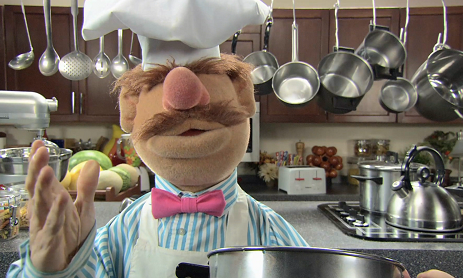
Anyone who has seen The Swedish Chef on The Muppet Show has realized that the comedy comes from the nonsense and the inevitable mess that the character makes. But did you know that these are also common pitfalls in real cooking? The nonsense usually comes from cooking in a hurry, not understanding the recipe or not taking the time to properly prepare ingredients while the mess usually comes from not getting everything organized before the cooking begins. As you can tell, this month's theme is cooking. To help with this there will be two posts per week for the month of April. Each post will also have two sections: The first section will detail some general cooking information or procedures and the second section will feature a recipe that you can try. Check out the online parts of the Scout Handbook on cooking, your regular Scout Handbook and the pamphlet for the Cooking Merit Badge for more information and most of all have fun!
A dutch oven is a medium-large cooking vessel with a lid that is typically made of cast iron, steel or ceramic materials. While not the lightest or smallest of options for cooking and extended trips it is certainly one of the best multi-taskers. Many recipes can be used with this single pot to greatly simplify your cooking and reduce the dishes that you have to clean. However, there are some special precautions that need to be used when using a dutch oven. Some recipes require that charcoal briquettes or coals be placed on the lid once it is on the oven - do not skip this because it sounds odd - the purpose is to create even heating and to increase the heat inside the dutch oven. Also, do not scrub the inside of a cast iron oven overly hard when cleaning and do not clean with soap as it removes the non-stick coating or "seasoning" from the oven and will make your next meals taste like soap. Always remember to reseason cast iron dutch ovens after they are clean and dry. Also avoid high acidity foods with a cast iron oven as this will promote rusting. If acidic foods are unavoidable simply rinse the oven immediately after it has cooled and don't delay the washing. Tips like these will help you get the most use out of a dutch oven as you develop your recipes and cooking skills.
Blackberry Cobbler
(Adapted from Byron's Dutch Oven Recipes)
4 cups fresh blackberries (or 2 bags of frozen then thawed)
1/2 cup sugar
1 1/2 tsp. grated lemon zest
1/4 cup water
Wash fresh blackberries and drain (or let frozen berries thaw then rinse). In a large bowl combine blackberries, 1/2 cup of sugar, lemon zest and water then stir to coat blackberries and let rest.
2 cups flour
2 cups sugar
1 Tbs. baking powder
1 tsp. salt
1 1/2 cups milk
In a separate bowl combine flour, 2 cups of sugar, baking powder and salt then stir to mix. Add milk and beat until batter is smooth.
1 stick butter
Melt butter using 10-12 briquettes under a 12" Dutch oven. Pour batter over melted butter slowly (do not stir). Carefully spoon blackberry mix over top of the batter (do not stir).
1 tsp. cinnamon
Sprinkle cinnamon over top.
Cover and bake using 10-12 briquettes under the dutch oven and 18-20 on the lid for 45 to 60 minutes. Rotate the oven and lid 1/4 turn in opposite directions every 10 minutes until crust is golden brown. Serves 10.